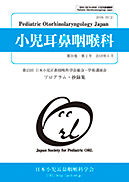Volume 42, Issue 1
Displaying 1-19 of 19 articles from this issue
- |<
- <
- 1
- >
- >|
Editorial
-
2021 Volume 42 Issue 1 Pages Ed1-Ed2
Published: 2021
Released on J-STAGE: July 31, 2021
Download PDF (202K)
The 15th Conference on Pediatric Otorhinolaryngology Japan
Symposium 1—Early approaches for children with suspected delayed verbal development
-
2021 Volume 42 Issue 1 Pages 1-6
Published: 2021
Released on J-STAGE: July 31, 2021
Download PDF (1848K) -
2021 Volume 42 Issue 1 Pages 7-10
Published: 2021
Released on J-STAGE: July 31, 2021
Download PDF (419K) -
2021 Volume 42 Issue 1 Pages 11-15
Published: 2021
Released on J-STAGE: July 31, 2021
Download PDF (356K) -
2021 Volume 42 Issue 1 Pages 16-21
Published: 2021
Released on J-STAGE: July 31, 2021
Download PDF (981K)
Symposium 2—Management of infections in pediatric otolaryngology with consideration of antimicrobial resistance (AMR): Theory and application
-
2021 Volume 42 Issue 1 Pages 22-26
Published: 2021
Released on J-STAGE: July 31, 2021
Download PDF (1121K) -
2021 Volume 42 Issue 1 Pages 27-31
Published: 2021
Released on J-STAGE: July 31, 2021
Download PDF (614K) -
2021 Volume 42 Issue 1 Pages 32-36
Published: 2021
Released on J-STAGE: July 31, 2021
Download PDF (523K) -
2021 Volume 42 Issue 1 Pages 37-42
Published: 2021
Released on J-STAGE: July 31, 2021
Download PDF (813K)
Symposium 3—Problems and treatment of sleep-disordered breathing in children
-
2021 Volume 42 Issue 1 Pages 43-46
Published: 2021
Released on J-STAGE: July 31, 2021
Download PDF (728K) -
2021 Volume 42 Issue 1 Pages 47-50
Published: 2021
Released on J-STAGE: July 31, 2021
Download PDF (494K)
Symposium 4—Management of children with mild to moderate hearing impairment
-
2021 Volume 42 Issue 1 Pages 51-54
Published: 2021
Released on J-STAGE: July 31, 2021
Download PDF (581K) -
2021 Volume 42 Issue 1 Pages 55-60
Published: 2021
Released on J-STAGE: July 31, 2021
Download PDF (609K) -
2021 Volume 42 Issue 1 Pages 61-65
Published: 2021
Released on J-STAGE: July 31, 2021
Download PDF (866K)
Crinical seminar
-
2021 Volume 42 Issue 1 Pages 66-71
Published: 2021
Released on J-STAGE: July 31, 2021
Download PDF (493K)
Original Articles
-
2021 Volume 42 Issue 1 Pages 72-77
Published: 2021
Released on J-STAGE: July 31, 2021
Download PDF (1202K) -
2021 Volume 42 Issue 1 Pages 78-86
Published: 2021
Released on J-STAGE: July 31, 2021
Download PDF (2143K)
Case Reports
-
2021 Volume 42 Issue 1 Pages 87-91
Published: 2021
Released on J-STAGE: July 31, 2021
Download PDF (522K) -
2021 Volume 42 Issue 1 Pages 92-95
Published: 2021
Released on J-STAGE: July 31, 2021
Download PDF (1851K)
- |<
- <
- 1
- >
- >|
